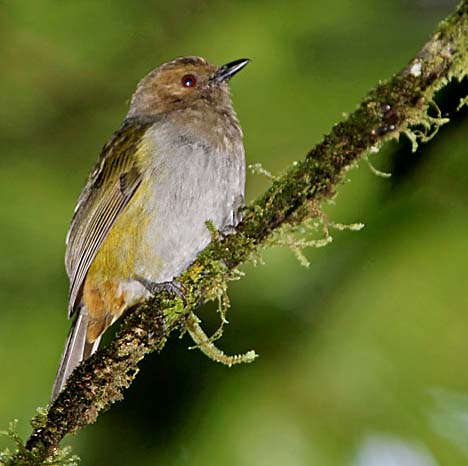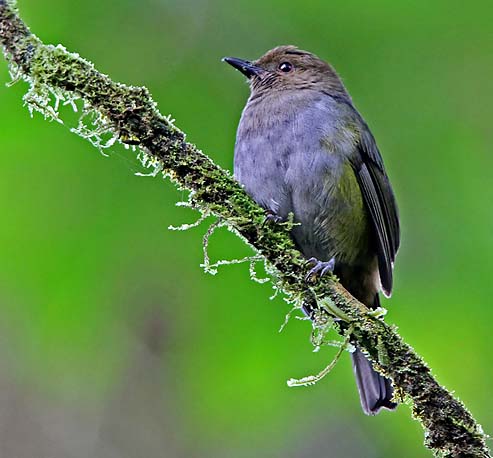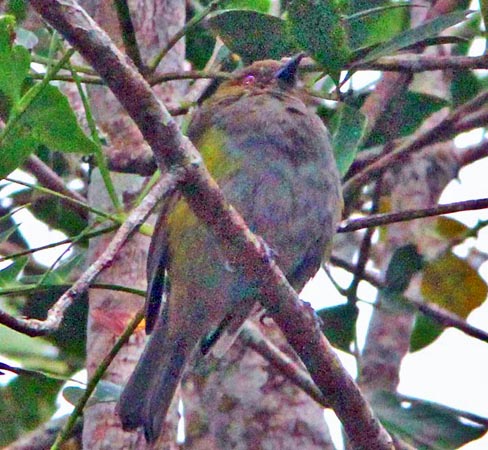| |
HYLOCITREA Hylocitreidae |
- 1 species on Sulawesi, Indonesia
- DR personal total: 1 species (100%), 1 photo'd
|
 Recent
genetic evidence has uncovered a number of completely unexpected
relationships between birds. To learn that the vocal Donacobius of the
Amazon Basin was a relict Old World grassbird was shocking, as were
findings that certain "babblers" in the Himalayas were actually close
relatives of New World vireos. But perhaps none have been more
unexpected than the 2008 discovery that an obscure "whistler" in the
undergrowth of montane forests on Sulawesi was actually a relict
bombycillid — related to the waxwings and relatives. This bird is Hylocitrea (left, in a fine shot by Rob Hutchinson), which is usually called the "Olive-flanked Whistler" or "Yellow-flanked Whistler." Recent
genetic evidence has uncovered a number of completely unexpected
relationships between birds. To learn that the vocal Donacobius of the
Amazon Basin was a relict Old World grassbird was shocking, as were
findings that certain "babblers" in the Himalayas were actually close
relatives of New World vireos. But perhaps none have been more
unexpected than the 2008 discovery that an obscure "whistler" in the
undergrowth of montane forests on Sulawesi was actually a relict
bombycillid — related to the waxwings and relatives. This bird is Hylocitrea (left, in a fine shot by Rob Hutchinson), which is usually called the "Olive-flanked Whistler" or "Yellow-flanked Whistler."
Spellman
et al. (2008) published this finding in their study of the
bombycillids. One of the authors, Rob Moyle, had found a tentative link
between Hylocitrea and bombycillids in an exploratory molecular
analysis. So a more detailed study of nuclear and mitochondrial genes
was undertaken for all putative members of this group, including
Hypocolius (an odd passerine from the Middle East) and Hylocitrea. The
analysis showed that both Hypocolius and Hylocitrea belong among the
lineage that gave rise to waxwings, silky-flycatchers, and the Palmchat
of Hispaniola. Spellman et al. (2008) recommended that each of these be
considered a subfamily of an enlarged Bombycillidae, but most recent
authorities prefer to split Hylocitrea into its own family, consistent
with prior treatments of Palmchat and Hypocolius. |
 The bird itself is an enigma. The Handbook of the Birds of the World
included it among the whistlers (Pachycephalidae; Boles 2007) but had
very little to say about it. In the introduction Boles (2007) mentioned
that "The Mottled Whistler (Rhagologus leucostigma) and the Yellow-flanked Whistler (Hylocitrea bonensis)
have primarily frugivorous diets, but it is questionable that this has
any important phylogenetic significance." Maybe not, but we now know
that Mottled "Whistler" of New Guinea is not a whistler, but is within
a clade that includes woodswallows and African bush-shrikes, with its
exact position still unknown (Norman et al. 2009). And we know that
"Yellow-flanked or Olive-flanked Whistler" is not a whistler, but is a
member of the bombycillid radiation. About all Boles (2007) says its
that the bird is "little known," eats "berries and some arthropods",
and "frequents middle storey and understorey," sometimes joining
"mixed-species flocks." The bird itself is an enigma. The Handbook of the Birds of the World
included it among the whistlers (Pachycephalidae; Boles 2007) but had
very little to say about it. In the introduction Boles (2007) mentioned
that "The Mottled Whistler (Rhagologus leucostigma) and the Yellow-flanked Whistler (Hylocitrea bonensis)
have primarily frugivorous diets, but it is questionable that this has
any important phylogenetic significance." Maybe not, but we now know
that Mottled "Whistler" of New Guinea is not a whistler, but is within
a clade that includes woodswallows and African bush-shrikes, with its
exact position still unknown (Norman et al. 2009). And we know that
"Yellow-flanked or Olive-flanked Whistler" is not a whistler, but is a
member of the bombycillid radiation. About all Boles (2007) says its
that the bird is "little known," eats "berries and some arthropods",
and "frequents middle storey and understorey," sometimes joining
"mixed-species flocks."
Its range is restricted to
higher elevations in Sulawesi, in moss forest usually above 2000m
[~6500' elev.], but it can descend to lower elevations from time to
time. It is best known from Lore Lindu and Dumoga-Bone National Parks.
The mossy forest nature of its habitat shows nicely in these photos. |
 There are whistlers that frequent the same montane habitat, such as the endemic Sulphur-bellied Whistler Pachycephalus sulfuriventer,
and until the genetic evidence, nothing about Hylocitrea caught
anyone's attention. Coates & Bishop (1997) says that it is
generally "inactive, inconspicuous and easily overlooked; seldom calls
or sings." Behaviorally, it "can be tame;" Holmes (1996). There are whistlers that frequent the same montane habitat, such as the endemic Sulphur-bellied Whistler Pachycephalus sulfuriventer,
and until the genetic evidence, nothing about Hylocitrea caught
anyone's attention. Coates & Bishop (1997) says that it is
generally "inactive, inconspicuous and easily overlooked; seldom calls
or sings." Behaviorally, it "can be tame;" Holmes (1996).
Coates
& Bishop (1997) described the song as a "series of insistent, thin,
high-pitched buzzy notes on the same pitch." Hmmm; like a waxwing?
Since
I wrote that musing in 2010, I've been to Sulawesi and have seen and
heard Hylocitrea (left). Its vocalizations do, indeed, recall waxwings.
|
Photos: Rob Hutchinson took the top two photo of the Hylocitrea Hylocitrea bonensis at Lore Lindu NP, Sulawesi, in September 2010. My photo was also in Lore Lindu NP, on 28 Sep 2011.
Uncredited photos © Don Roberson. Credited photos © Rob Hutchinson/Birdtour Asia, as credited, and used with permission; all rights reserved.
Bibliographic note: There is obviously no "family book" and it is barely touched in HBW (no photo; Boles 2007).
Literature cited:
Boles, W.E. 2007. Family Pachycephalidae (Whistlers), pp. 374 –437 in
Handbook of the Birds of the World (del Hoyo, J., A. Elliott & D.A.
Christie, eds). Vol. 12. Lynx Edicions, Barcelona, Spain.
Coates,
B.J., and K.D. Bishop. 1997. A Guide to the Birds of Wallacea:
Sulawesi, the Moluccas and Lesser Sunda Islands, Indonesia. Dove Publ.,
Alderly, Australia.
Holmes, D. 1996. The Birds of Sulawesi. Oxford Univ. Press, Kuala Lumpur.
Norman,
J.A., P.G.P. Ericson, K.A. Jønsson, J. Fjeldså, and L.
Christidis. 2009. A multi-gene phylogeny reveals novel relationships
for aberrant genera of Australo-Papuan core Corvoidea and polyphyly of
the Pachycephalidae and Psophodidae (Aves: Passeriformes). Molec.
Phylog. Evol. 52: 488-497.
Spellman, G.M., A.
Cibois, R.G. Moyle, K. Winker, and F.K. Barker. 2008. Clarifying the
systematics of an enigmatic avian lineage: what is a bombycillid?
Molec. Phylog. Evol. 49: 1036-1040.
|
|
|

 Recent
genetic evidence has uncovered a number of completely unexpected
relationships between birds. To learn that the vocal Donacobius of the
Amazon Basin was a relict Old World grassbird was shocking, as were
findings that certain "babblers" in the Himalayas were actually close
relatives of New World vireos. But perhaps none have been more
unexpected than the 2008 discovery that an obscure "whistler" in the
undergrowth of montane forests on Sulawesi was actually a relict
bombycillid — related to the waxwings and relatives. This bird is Hylocitrea (left, in a fine shot by Rob Hutchinson), which is usually called the "Olive-flanked Whistler" or "Yellow-flanked Whistler."
Recent
genetic evidence has uncovered a number of completely unexpected
relationships between birds. To learn that the vocal Donacobius of the
Amazon Basin was a relict Old World grassbird was shocking, as were
findings that certain "babblers" in the Himalayas were actually close
relatives of New World vireos. But perhaps none have been more
unexpected than the 2008 discovery that an obscure "whistler" in the
undergrowth of montane forests on Sulawesi was actually a relict
bombycillid — related to the waxwings and relatives. This bird is Hylocitrea (left, in a fine shot by Rob Hutchinson), which is usually called the "Olive-flanked Whistler" or "Yellow-flanked Whistler."  The bird itself is an enigma. The Handbook of the Birds of the World
included it among the whistlers (Pachycephalidae; Boles 2007) but had
very little to say about it. In the introduction Boles (2007) mentioned
that "The Mottled Whistler (Rhagologus leucostigma) and the Yellow-flanked Whistler (Hylocitrea bonensis)
have primarily frugivorous diets, but it is questionable that this has
any important phylogenetic significance." Maybe not, but we now know
that Mottled "Whistler" of New Guinea is not a whistler, but is within
a clade that includes woodswallows and African bush-shrikes, with its
exact position still unknown (Norman et al. 2009). And we know that
"Yellow-flanked or Olive-flanked Whistler" is not a whistler, but is a
member of the bombycillid radiation. About all Boles (2007) says its
that the bird is "little known," eats "berries and some arthropods",
and "frequents middle storey and understorey," sometimes joining
"mixed-species flocks."
The bird itself is an enigma. The Handbook of the Birds of the World
included it among the whistlers (Pachycephalidae; Boles 2007) but had
very little to say about it. In the introduction Boles (2007) mentioned
that "The Mottled Whistler (Rhagologus leucostigma) and the Yellow-flanked Whistler (Hylocitrea bonensis)
have primarily frugivorous diets, but it is questionable that this has
any important phylogenetic significance." Maybe not, but we now know
that Mottled "Whistler" of New Guinea is not a whistler, but is within
a clade that includes woodswallows and African bush-shrikes, with its
exact position still unknown (Norman et al. 2009). And we know that
"Yellow-flanked or Olive-flanked Whistler" is not a whistler, but is a
member of the bombycillid radiation. About all Boles (2007) says its
that the bird is "little known," eats "berries and some arthropods",
and "frequents middle storey and understorey," sometimes joining
"mixed-species flocks." There are whistlers that frequent the same montane habitat, such as the endemic Sulphur-bellied Whistler Pachycephalus sulfuriventer,
and until the genetic evidence, nothing about Hylocitrea caught
anyone's attention. Coates & Bishop (1997) says that it is
generally "inactive, inconspicuous and easily overlooked; seldom calls
or sings." Behaviorally, it "can be tame;" Holmes (1996).
There are whistlers that frequent the same montane habitat, such as the endemic Sulphur-bellied Whistler Pachycephalus sulfuriventer,
and until the genetic evidence, nothing about Hylocitrea caught
anyone's attention. Coates & Bishop (1997) says that it is
generally "inactive, inconspicuous and easily overlooked; seldom calls
or sings." Behaviorally, it "can be tame;" Holmes (1996).